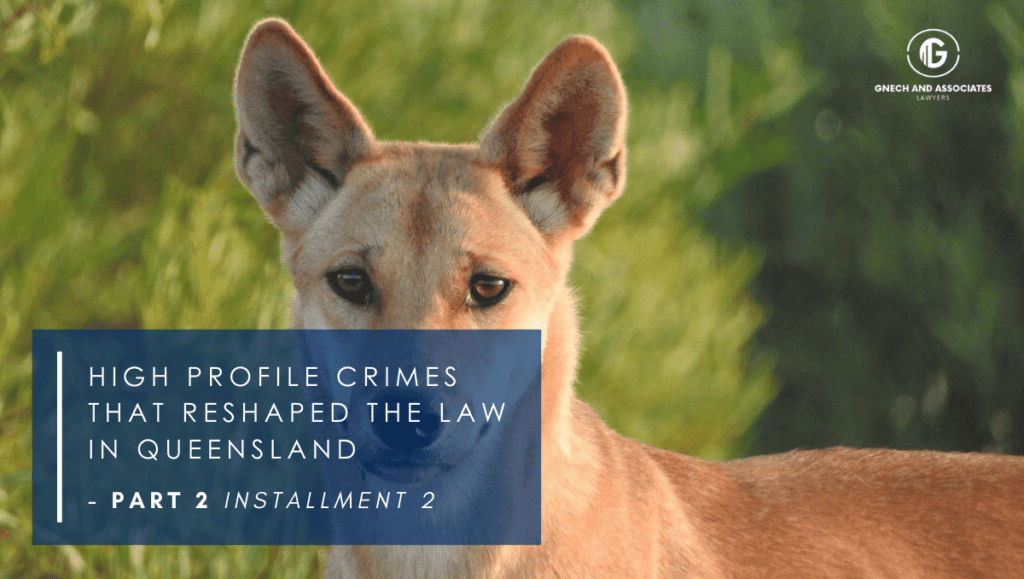The Chamberlain Case – Installment 2 of 2

By Calvin Gnech, Criminal Lawyer and Legal Practice Director at Gnech and Associates
2 October 2020
This article has been taken from the notes of Glen Cranny, partner of Gilshenan & Luten Legal Practice, from an oral presentation he presented to Justice Studies teachers in 2003.
The Chamberlain Case and Scientific/Expert Evidence
This article is a follow up from the analysis of the Chamberlain case in regard to circumstantial evidence. The second and possibly more intriguing aspect of the Chamberlain Case is the issue of scientific/expert evidence. As we know, Azaria disappeared on 17 August, 1980, and her remains were never located. Some of her clothing was found a week later. This clothing became vitally important in later theories surrounding her disappearance.
Importantly, there was no positive identification of dingo hairs or dingo saliva on any of the clothing recovered. The matinee jacket, of course, was recovered years later in 1986. Examinations of Azaria’s clothing led to great suspicion surrounding her parents, Michael and Lindy Chamberlain, and as a result a series of scientific tests were then conducted with a view to investigating the matter. Nearly 31 years on, it is apparent these ‘tests’ were quite graciously called ‘scientific tests’.
Experts and the Attempts to Replicate a Dingo Attack
A forensic odontologist and consultant botanist were involved in an attempted replication of a dingo attack where they wrapped similar baby clothing around a skinned goat carcass and offered it to a deliberately starved dingo at the Adelaide Zoo. This was meant to provide some guidance as to how a dingo may have damaged Azaria’s clothing, if Mrs Chamberlain’s story were to be believed.

The same two experts later flew to Ayers Rock and conducted an experiment whereby they dragged a jumpsuit via a particular device through the desert at the height of a dingo’s head to see what vegetation would be embedded in the fabric during the course of the dingo’s alleged travels.
The Discovery of ‘Foetal Blood’
Ultimately, a variety of experts interpreted the damage to Azaria’s jumpsuit as being too inconsistent with what might be expected from a dingo attack. These interpretations greatly expanded investigations and ultimately resulted in the “discovery” of foetal blood in the Chamberlain’s car. This evidence overshadowed much of the other evidence in the trial.
A Battery of Expert Evidence
The case against the Chamberlains at trial was compelling, particularly due to the battery of expert evidence aligned against them. There was foetal blood found in the Chamberlain’s car with only a small amount in the tent where the baby was supposedly taken by the dingo. There was no dingo saliva or hair on the baby’s clothing at all.
Experts said that the damage to the baby’s clothing was caused by scissors rather than a dog and that the markings were entirely inconsistent with a dingo attack.
Inquiry Finding Regarding the Scientific and Expert Evidence
A Royal Commission of Inquiry before Justice Trevor Morling was held in 1986/87, the vast bulk of the scientific/expert evidence which helped convict the Chamberlains was shown to be either very shaky, and in some startling cases, absolutely and fundamentally wrong. (The inquiry came four years after the Chamberlains were convicted in the Northern Territory Supreme Court, three years after the Federal Court Appeal and two years after the High Court Appeal.)
The Crown’s Allegations
It was the Crown allegation that Lindy Chamberlain had left the barbeque area on the night in question and had taken Azaria to the front passenger seat of her car and slit her throat. It was alleged that Azaria was then secreted in the car and then later that evening, buried in the sand nearby. It was alleged that Azaria’s clothing had been cut so as to simulate dingo damage.

The jury was invited to find that Azaria’s blood was not shed in the tent, but the small amount of blood found there was transferred by Lindy Chamberlain. The jury was also invited to conclude that her story of a dingo taking her baby was a fabrication.
A Significant Hurdle for the Defence
At trial, the evidence of foetal blood in the Chamberlain’s car was a significant hurdle for defence to overcome. The Morling Inquiry concluded that there was compelling evidence that the staining in the car, initially thought to be foetal blood, was not only in fact not blood at all, but was a sound deadening compound used in the manufacture of the car. This has perhaps proved to be the most astounding mistake in Australian forensic history.
The Textile Expert
Further, the very same textile expert who at trial had indicated that the jumpsuit had been cut by sharp scissors and not by a dingo, conceded to the Morling Royal Commission that some of the most important points of his evidence at trial had been erroneous.
This allowed the Commission to ultimately find that it was impossible to tell whether the damage had been done by scissors, or a knife or the teeth of a dog.
The Matinee Jacket and the Dingo Behaviouralists
It was also pointed out that the fact that Azaria’s matinee jacket was discovered in 1986, well after the Chamberlain’s trial, explained the failure to initially detect dingo saliva and hair on the jumpsuit and clothing of the baby.
Finally, in relation to the evidence of dingo behaviouralists, the Morling Royal Commission concluded that there was a significant divergence of views in relation to such evidence and it could not be concluded that a dingo could not have taken the baby.
Scrutinising Expert Evidence
Expert evidence can be the final part to a successful prosecution, but the courts scrutinise this evidence for reasons demonstrated above in the Chamberlain case. Subject to some minor qualifications in more recent judgement Heydon JA, as he was, in Makita (Australia) Pty Ltd v Sprowles (2001) 52 NSWLR 705 outlines expert/opinion evidence rules generally. At 743-744, His Honour stated:-
“In short, if evidence tendered as expert opinion evidence is to be admissible, it must be agreed or demonstrated that there is a field of “specialised knowledge”; there must be an identified aspect of that field in which the witness demonstrates that by reason of specified training, study or experience, the witness has become an expert; the opinion proffered must be “wholly or substantially based on the witness’s expert knowledge”; so far as the opinion is based on facts “observed” by the expert, they must be identified and admissibly proved by the expert, and so far as the opinion is based on “assumed” or “accepted” facts, they must be identified and proved in some other way; it must be established that the facts on which the opinion is based form a proper foundation for it; and the opinion of an expert requires demonstration or examination of the scientific or other intellectual basis of the conclusions reached: that is, the expert’s evidence must explain how the field of “specialised knowledge” in which the witness is expert by reason of “training, study or experience”, and on which the opinion is “wholly or substantially based”, applies to the facts assumed or observed so as to produce the opinion propounded.
If all these matters are not made explicit, it is not possible to be sure whether the opinion is based wholly or substantially on the expert’s specialised knowledge. If the court cannot be sure of that, the evidence is strictly speaking not admissible, and, so far as it is admissible, of diminished weight.”
‘Expert evidence and the Family Pet’
Barrister Stephen Fynes-Clinton authored an article called ‘Expert evidence and the Family Pet’ in issue 24, April 2008 of the Qld Bar publication Hearsay. This is a very helpful summary of authorities that have considered the general set out above by Heydon JA, as he then was. This article can be found at http://www.hearsay.org.au/index.php?

